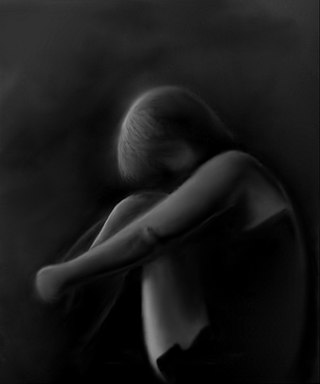Related Research Articles

Antipsychotics, also known as neuroleptics, are a class of psychotropic medication primarily used to manage psychosis, principally in schizophrenia but also in a range of other psychotic disorders. They are also the mainstay together with mood stabilizers in the treatment of bipolar disorder.

Bipolar disorder, previously known as manic depression, is a mental disorder characterized by periods of depression and periods of abnormally elevated mood that each last from days to weeks. If the elevated mood is severe or associated with psychosis, it is called mania; if it is less severe, it is called hypomania. During mania, an individual behaves or feels abnormally energetic, happy or irritable, and they often make impulsive decisions with little regard for the consequences. There is usually also a reduced need for sleep during manic phases. During periods of depression, the individual may experience crying and have a negative outlook on life and poor eye contact with others. The risk of suicide is high; over a period of 20 years, 6% of those with bipolar disorder died by suicide, while 30–40% engaged in self-harm. Other mental health issues, such as anxiety disorders and substance use disorders, are commonly associated with bipolar disorder.
Bipolar I disorder is a type of bipolar spectrum disorder characterized by the occurrence of at least one manic episode, with or without mixed or psychotic features. Most people also, at other times, have one or more depressive episodes.
Psychosis is a condition of the mind that results in difficulties determining what is real and what is not real. Symptoms may include delusions and hallucinations, among other features. Additional symptoms are incoherent speech and behavior that is inappropriate for a given situation. There may also be sleep problems, social withdrawal, lack of motivation, and difficulties carrying out daily activities. Psychosis can have serious adverse outcomes.

A mood disorder, also known as an affective disorder, is any of a group of conditions of mental and behavioral disorder where a disturbance in the person's mood is the main underlying feature. The classification is in the Diagnostic and Statistical Manual of Mental Disorders (DSM) and International Classification of Diseases (ICD).

Borderline personality disorder (BPD), also known as emotionally unstable personality disorder (EUPD), is a personality disorder characterized by a long-term pattern of intense and unstable interpersonal relationships, distorted sense of self, and strong emotional reactions. Those affected often engage in self-harm and other dangerous behaviors, often due to their difficulty with returning their emotional level to a healthy or normal baseline. They may also struggle with dissociation, a feeling of emptiness, and a fear of abandonment.
Schizoaffective disorder is a mental disorder characterized by abnormal thought processes and an unstable mood. This diagnosis requires symptoms of both schizophrenia and a mood disorder: either bipolar disorder or depression. The main criterion is the presence of psychotic symptoms for at least two weeks without any mood symptoms. Schizoaffective disorder can often be misdiagnosed when the correct diagnosis may be psychotic depression, bipolar I disorder, schizophreniform disorder, or schizophrenia. This is a problem as treatment and prognosis differ greatly for most of these diagnoses.

Psychotic depression, also known as depressive psychosis, is a major depressive episode that is accompanied by psychotic symptoms. It can occur in the context of bipolar disorder or major depressive disorder. It can be difficult to distinguish from schizoaffective disorder, a diagnosis that requires the presence of psychotic symptoms for at least two weeks without any mood symptoms present. Unipolar psychotic depression requires that psychotic symptoms occur during severe depressive episodes, although residual psychotic symptoms may also be present in between episodes. Diagnosis using the DSM-5 involves meeting the criteria for a major depressive episode, along with the criteria for "mood-congruent or mood-incongruent psychotic features" specifier.
Psychiatric genetics is a subfield of behavioral neurogenetics and behavioral genetics which studies the role of genetics in the development of mental disorders. The basic principle behind psychiatric genetics is that genetic polymorphisms are part of the causation of psychiatric disorders.
Peter McGuffin is a psychiatrist and geneticist from Belfast, Northern Ireland.
A spectrum disorder is a disorder that includes a range of linked conditions, sometimes also extending to include singular symptoms and traits. The different elements of a spectrum either have a similar appearance or are thought to be caused by the same underlying mechanism. In either case, a spectrum approach is taken because there appears to be "not a unitary disorder but rather a syndrome composed of subgroups". The spectrum may represent a range of severity, comprising relatively "severe" mental disorders through to relatively "mild and nonclinical deficits".
Child and adolescent psychiatry is a branch of psychiatry that focuses on the diagnosis, treatment, and prevention of mental disorders in children, adolescents, and their families. It investigates the biopsychosocial factors that influence the development and course of psychiatric disorders and treatment responses to various interventions. Child and adolescent psychiatrists primarily use psychotherapy and/or medication to treat mental disorders in the pediatric population.

Grandiose delusions (GD), also known as delusions of grandeur or expansive delusions, are a subtype of delusion that occur in patients with a wide range of psychiatric disorders, including two-thirds of patients in a manic state of bipolar disorder, half of those with schizophrenia, patients with the grandiose subtype of delusional disorder, frequently as a comorbid condition in narcissistic personality disorder, and a substantial portion of those with substance abuse disorders. GDs are characterized by fantastical beliefs that one is famous, omnipotent, wealthy, or otherwise very powerful. The delusions are generally fantastic and typically have a religious, science fictional, or supernatural theme. There is a relative lack of research into GD, in contrast to persecutory delusions and auditory hallucinations. Around 10% of healthy people experience grandiose thoughts at some point in their lives but do not meet full criteria for a diagnosis of GD.
Sophia Frangou is a professor of psychiatry at the Icahn School of Medicine at Mount Sinai where she heads the Psychosis Research Program. She is a Fellow of the Royal College of Psychiatrists and vice-chair of the RCPsych Panamerican Division. She is a Fellow of the European Psychiatric Association (EPA) and of the American Psychiatric Association (APA). She served as vice-president for Research of the International Society for Bipolar Disorders from 2010 to 2014. She has also served on the Council of the British Association for Psychopharmacology. She is founding member of the EPA NeuroImaging section and founding chair of the Brain Imaging Network of the European College of Neuropsychopharmacology. She is one of the two Editors of European Psychiatry, the official Journal of the European Psychiatric Association.
Childhood schizophrenia is similar in characteristics of schizophrenia that develops at a later age, but has an onset before the age of 13 years, and is more difficult to diagnose. Schizophrenia is characterized by positive symptoms that can include hallucinations, delusions, and disorganized speech; negative symptoms, such as blunted affect and avolition and apathy, and a number of cognitive impairments. Differential diagnosis is problematic since several other neurodevelopmental disorders, including autism spectrum disorder, language disorder, and attention deficit hyperactivity disorder, also have signs and symptoms similar to childhood-onset schizophrenia.
The diagnosis of schizophrenia, a psychotic disorder, is based on criteria in either the American Psychiatric Association's Diagnostic and Statistical Manual of Mental Disorders, or the World Health Organization's International Classification of Diseases (ICD). Clinical assessment of schizophrenia is carried out by a mental health professional based on observed behavior, reported experiences, and reports of others familiar with the person. Diagnosis is usually made by a psychiatrist. Associated symptoms occur along a continuum in the population and must reach a certain severity and level of impairment before a diagnosis is made. Schizophrenia has a prevalence rate of 0.3-0.7% in the United States

Melancholic depression, or depression with melancholic features, is a DSM-IV and DSM-5 specifier of depressive disorders. This type of depression has specific symptoms that make it different from the standard clinical depression list of symptoms. Furthermore, melancholic depression has a specific subset of causes and can respond differently to treatment than other clinical depression types.
Schizophrenia is a primary psychotic disorder, whereas, bipolar disorder is a primary mood disorder which can also involve psychosis. Both schizophrenia and bipolar disorder are characterized as critical psychiatric disorders in the Diagnostic and Statistical Manual of Mental Disorders fifth edition (DSM-5). However, because of some similar symptoms, differentiating between the two can sometimes be difficult; indeed, there is an intermediate diagnosis termed schizoaffective disorder.
Ming Tso Tsuang is an American psychiatrist and Distinguished Professor of Psychiatry at the University of California, San Diego. He is considered a pioneering researcher in the genetic epidemiology of schizophrenia and other severe mental disorders. Tsuang has authored and co-authored more than 600 publications and serves as founding and senior editor of the American Journal of Medical Genetics Part B.
Unipolar mania is a form of bipolar disorder whereby individuals only experience manic episodes without depression. Depression is often characterised by a persistent low mood, decreased energy and thoughts of suicide. What is seen as its counterpart, mania, can be characterized by racing thoughts, less need for sleep and psychomotor agitation.
References
- Cardno AG, Rijsdijk FV, Sham PC, Murray RM, McGuffin P (April 2002). "A twin study of genetic relationships between psychotic symptoms". Am J Psychiatry. 159 (4): 539–45. doi:10.1176/appi.ajp.159.4.539. PMID 11925290.
- Cardno AG, Marshall EJ, Coid B, et al. (February 1999). "Heritability estimates for psychotic disorders: the Maudsley twin psychosis series". Arch. Gen. Psychiatry. 56 (2): 162–8. doi:10.1001/archpsyc.56.2.162. PMID 10025441.